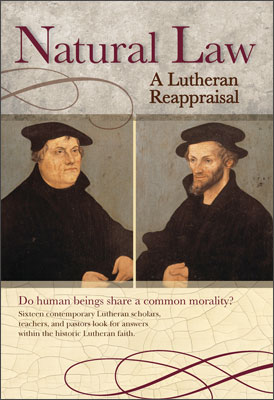Counseling under the Cross, by H. Curtis Lyon (Milwaukee: Northwestern Publishing House, 1991)
Intended for pastors but readily applicable to laypeople, Pastor H. Curtis Lyon’s Counseling under the Cross provides valuable insights and helpful advice for recognizing God’s mercy amid difficult situations. Drawing from a wealth of parish experience, the author identifies guilt as the root of most psychological problems and demonstrates the healing power of a specific application of Law followed by a specific application of Gospel as the two-step process essential for genuine healing. In other words, Christian counseling consists essentially of Confession and Absolution. Far from a trite reduction of life’s vexing problems to a few platitudes from the Catechism, Lyon’s formula is a personal, sensitive, and winsome approach centered on the powerful Gospel message that Christ took my own sins to the cross and that, therefore, I now can live in freedom from whatever may be haunting me about my past. This brief, excellent, and highly readable book belongs on the desk of every pastor and also would be a valuable asset for any Christian’s home library, especially for parents, grandparents, and other mentors in the faith.
The Purpose of Counseling
Pastor Lyon states at the onset that “the purpose of counseling … is to build faith through the application of the Word of God and to arrive at the resolution of various guilt problems and their related distress” (i–x). As the book progresses, Lyon reveals the manner in which hidden guilt, sometimes suppressed for years, can lurk underneath layers of more obvious problems, including severe cases for which psychiatric treatment may be sought. Rather than discounting the insights of psychiatrists and psychologists, he suggests that social science and medication may have appropriate contributions toward the resolution of people’s problems, but he insists that lasting healing comes from the Word of God, as the Law exposes one’s guilt over a particular sin and the Gospel comforts with forgiveness for that particular sin.
Drawing from John 21:15–19, Lyons notes that “Jesus’ message to Peter was not a generalized description of law and gospel. The message was meant just for him” (3). Similarly, pastors or other Christian counselors today must provide a personalized application of God’s Word to the unique struggles that individuals are facing. In a reminder applicable equally to parents and friends as to pastors and professional counselors, Lyon emphasizes the importance of speaking the efficacious Word of God to one another. “Only when we talk to others can we give the relief Christ provides. That relief of heart, conscience, and mind is what we mean by gospel resolution” (4).
The Method of Gospel Resolution
Lyon warns that “too often pastors and teachers may give prepackaged answers to personal problems people have without first listening to a thorough presentation of the problems” (20). True, every human problem is rooted in sin and therefore the solution always is the Gospel. However, “our people need not only the law and gospel, they also need to understand what the law and gospel say to them personally” (21). By listening, and by asking questions that evoke a narrative response rather than a simple yes/no answer, pastors (or parents or Christian friends—anyone seeking to offer biblical counsel) can discover the problem-behind-the-problem, and that problem usually involves personal guilt. Lyon provides numerous examples from his own ministry. One woman felt burdened by many things until he helped her realize that she was trying in vain to let God help her to handle her problems, when in fact “God didn’t promise to help her carry her burdens, he wanted to carry them for her” (24, emphasis added). Her God-and-me-working-together approach really amounted to a violation of the First Commandment; she was not relying upon God alone, but upon a false god of her own making.
Lyon demonstrates from his interactions with psychiatrists and psychologists as well as his experience with his own parishioners that depression, alcoholism, schizophrenia, marital breakdown, etc. nearly always involve personal guilt at the root. Even a person who has been the victim of abuse also typically carries guilt for some aspect of the situation, such as feeling angry rather than forgiving (for as difficult as forgiveness may be, it is what God expects of His children toward one another). For example, through talking with a woman whose husband had been having an extramarital affair, Lyon discovered that although she rightfully identified his actions as sinful, she also felt guilty for her own unwillingness to forgive him. She had in fact trapped herself into a cycle of feeling anger rather than forgiveness toward him, and then feeling guilty about her anger, as if by feeling guilty over the anger she could somehow make up for her anger. Her pastor reminded her that nothing she could do would ever make up for anything else that she had done. She needed Christ’s forgiveness first, and then she could share it also with her husband. “Christ forgiveness equipped her to forgive her husband and she could also forgive herself” (35).
In other examples, Lyon reveals how “some parents try to take responsibility for their children” to the extent that “they bear the guilt for virtually everything their children do.” Similarly, one spouse may try to assume responsibility when the other spouse commits adultery. “If she had been a better wife, perhaps her husband would not have left,” she thinks (94). What is the common thread throughout all of these examples? When a person poses as God—trying to pay for one’s own guilt, trying to take on someone else’s guilt, etc.—the First Commandment is violated and emotional disturbances inevitably follow. “Carrying guilt needlessly,” warns Lyon, “is just as misdirected as pretending guilt doesn’t exist” (107). Fortunately, God has a better plan.
A Trip to the Cross
Genuine Christian counseling centers around the specific and personalized application of Christ’s forgiving love to a person desperately in need of it. Lyon warns that “simply using God’s name on otherwise unscriptural material does not sanctify the material and give it the power the gospel has. … No therapy, no book, no tape will do anything to add to the power of God’s word. The gospel has the power to save, and with that salvation comes peace.” (47, 49). Simply put, Christian counseling brings people to Christ.
In order to ensure that people receive a personalized application of the Gospel, Lyon recommends taking them on a “trip to the cross,” where they can drop the burden of their sin at the feet of Jesus. Although life-long Christians may know, intellectually, the details of how Christ accomplished their salvation, a vivid and personalized reminder helps to drive the Gospel message home to them anew. Lyon suggests a dialogue built around prompts such as: “What was Jesus doing? He was suffering and dying on the cross. Why was he doing that? He was winning forgiveness for the world. Whom did Jesus forgive? He forgave her. Whom else did he forgive? He also forgave her father.” (87–88) Such a dialogue would also serve as excellent preparation for receiving the Lord’s Supper, in which Christ distributes the benefits He won uon the cross.
Does such “counseling under the cross” work? Lyon concludes: “My experience is that the trip to the cross produces in six weeks or less with one hour a week, what months and years of counseling and medication have not otherwise been able to accomplish.” The Gospel is, after all, the power of God unto salvation (Romans 1:16).
The success of Christian counseling becomes obvious when “the person whose problem has been resolved by gospel resolution will no longer seek other forms of attempted resolution,” such as the guilt-shifting techniques mentioned above (144). With guilt removed by Christ alone, lasting peace may begin. Relationships may heal. Lyon makes no pretense to any of this being easy; his case studies include complicated, difficult situations, sometimes involving severe psychiatric problems. Even so, Lyon wants his readers to know that God is bigger than those problems. Jesus went to the cross to bring forgiveness and lasting peace to each and every person, no matter how tough the situation or how deep the hurt.
Thankfully, this “NPH Classic” has recently been released in a Kindle edition, as well as in a 2011 paperback reprint. Anyone involved in Christian counseling—and that would include anyone upon whose shoulder a friend has ever cried—will find Counseling under the Cross to be a valuable resource.
Dr. Ryan C. MacPherson is the founding president of The Hausvater Project. He lives with his wife Marie and their homeschool children in Casper, Wyoming, where he serves as Academic Dean and Professor of History and Philosophy at Luther Classical College. He previously taught American history, history of science, and bioethics at Bethany Lutheran College, 2003–2023. For more information, visit www.ryancmacpherson.com.




